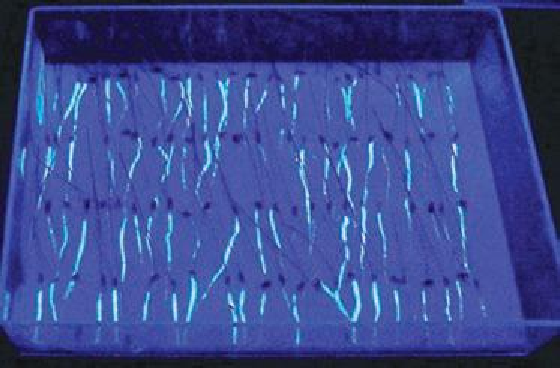Agriculture Reference
In-Depth Information
Figure 9.9. The luorescence test for annual and perennial ryegrass. Roots of annual ryegrass luoresce upon
exposure to UV light while the roots of perennial type do not luoresce.
4. On the 7th day, drain excess moisture from the boxes and expose the seedlings to ultraviolet light
in a dark room. With an indelible pencil, mark luorescing seedlings in perennial ryegrass tests
and nonluorescing seedlings in annual ryegrass tests. The luorescent substance remains perma-
nent on the dry paper. Roots not adhering entirely to the paper produce broken luorescent lines,
and should be classiied as annual type.
5. Evaluate seedlings in normal light. Remove and record the number of normal seedlings which
luoresce. If less than 75% of the seedlings luoresce, break the contact of the nonluorescent seed-
lings with the paper by transferring nonluorescent seedlings along with the abnormal seedlings
and ungerminated seeds to fresh paper prepared as in step 1. Return to the germinator. Continue
all tests an additional 7 days.
6. On the 14th day, expose the remaining seedlings to ultraviolet light again and make the inal
evaluation. Care must be taken not to recount any luorescent lines counted on the irst reading.
Determine the total number of normal seedlings and the total number of those normal seedlings
which luoresced.
7. Report percentages of germination and luorescent seedlings and nonluorescent seedlings as
follows:
%germination=
No.normalseedlingsX100
400
ᅠ
%fluorescentseedlings(TFL)=
No.fluorescentseedlingsX100
Totalno.of normalseedlings

